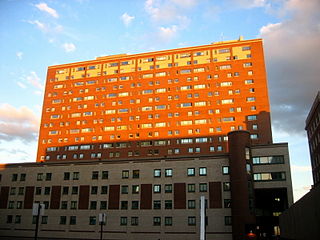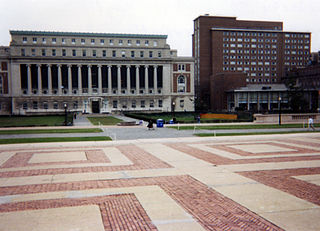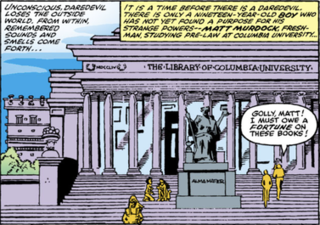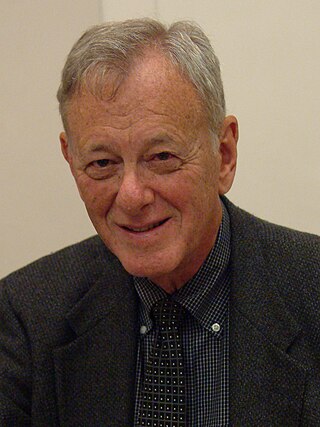
Jean-Louis Lebris de Kérouac, known as Jack Kerouac, was an American novelist and poet who, alongside William S. Burroughs and Allen Ginsberg, was a pioneer of the Beat Generation.

Vanity of Duluoz: An Adventurous Education, 1935–46 is a 1968 semi-autobiographical novel by Jack Kerouac. The book describes the adventures of Kerouac's alter ego, Jack Duluoz, covering the period of his life between 1935 and 1946. The book includes reminiscences of the author's high school experiences in Lowell, Massachusetts, his education at Columbia University, and his subsequent naval service during World War II. It culminates with the beginnings of the beat movement. It was Kerouac's last work published during his life. The tone of the book has been noted for its stark contrast to On the Road.

Columbia College is the oldest undergraduate college of Columbia University, a private Ivy League research university in New York City. Situated on the university's main campus in Morningside Heights in the borough of Manhattan, it was founded by the Church of England in 1754 as King's College by royal charter of King George II of Great Britain. It is Columbia University's traditional undergraduate program, offering BA degrees, and is the oldest institution of higher learning in the state of New York and the fifth oldest in the United States.

Lucien Carr was a key member of the original New York City circle of the Beat Generation in the 1940s and also a convicted manslaughterer. He later worked for many years as an editor for United Press International.
Edie Kerouac-Parker was the author of the memoir You'll Be Okay, about her life with her first husband, Jack Kerouac, and the early days of the Beat Generation. While an art student under George Grosz at Barnard College, she and fellow Barnard student and friend Joan Vollmer shared an apartment on 118th Street in New York City which came to be frequented by many of the then unknown Beats, among them Vollmer's eventual husband William S. Burroughs, and fellow Columbia students Jack Kerouac and Allen Ginsberg as well as Lucien Carr.

Desolation Angels is a semi-autobiographical novel written by Beat Generation author Jack Kerouac, which makes up part of his Duluoz Legend. It was published in 1965, but was written years earlier, around the time On the Road was in the process of publication. The events described in the novel take place from 1956-1957. Much of the psychological struggle which the novel's protagonist, Jack Duluoz, undergoes in the novel reflects Kerouac's own increasing disenchantment with the Buddhist philosophy. Throughout the novel, Kerouac discusses his disenchantment with fame, and complicated feelings towards the Beat Generation. He also discusses his relationship with his mother and his friends such as Allen Ginsberg, Neal Cassady, Lucienn Carr and William S. Burroughs. The novel is also notable for being a relatively positive portrayal of homosexuality and homosexual characters, despite its use of words that were at the time considered homophobic slurs.
The West End Bar, also known for a time as the "West End Gate", was located on Broadway near 114th Street in Morningside Heights, Manhattan, New York City. From its establishment in 1911, the bar served as a common gathering place for Columbia University students, faculty and administration. The bar was also a meeting place for many Beat Generation writers as well as many 1960s student activists when they attended the university.

John Jay Hall is a 15-story building located on the southeastern extremity of the Morningside Heights campus of Columbia University in New York City, on the northwestern corner of 114th St. and Amsterdam Avenue. Named for Founding Father, The Federalist Papers author, diplomat, and first Chief Justice of the United States Supreme Court John Jay, it was among the last buildings designed by the architectural firm of McKim, Mead & White, which had provided Columbia's original Morningside Heights campus plan, and was finished in 1927.

East Campus is a prominent building on the Morningside Heights campus of Columbia University in New York City, located along Morningside Drive between 117th and 118th Streets. One of the tallest buildings in the neighborhood, it serves primarily as a residence hall for Columbia undergraduates, although it also contains a small hotel, the university's Center for Career Education, its Facilities Management office, and the Heyman Center for the Humanities. East Campus, a $28.7 million facility, was designed by Gwathmey Siegel & Associates Architects and built in 1979-1982.

The Liberty Cup is a trophy awarded to the winner of the college football game between Columbia University and Fordham University, two National Collegiate Athletic Association (NCAA) Division I football programs in New York City. The cup was awarded annually from 2002 to 2015, but the two teams have not met since then.

Hartley Hall was the first official residence hall constructed on the campus of Columbia University's Morningside Heights campus, and houses undergraduate students from Columbia College as well as the Fu Foundation School of Engineering and Applied Science. The building is named for Columbia alumnus Marcellus Hartley Dodge, who donated $300,000 for its construction shortly after his graduation. The building was meant as a memorial to his grandfather, Marcellus Hartley, the owner of Remington Arms, who died during Dodge's sophomore year and who bequeathed him the family fortune. Dodge hoped to create “the commencement of a true dormitory system" at Columbia.

Hogan Hall is a dormitory of Columbia University primarily reserved for fourth-year undergraduate students. The dorm is popular for its suite configurations as well as its central location. Built in 1898 as a nursing home, the building was converted to graduate student housing in 1977. It was named after Frank S. Hogan. It was converted into an undergraduate residence in 1994, then renovated in 2000 with the completion of a new entrance connecting it to Broadway Hall, designed by Robert A.M. Stern Architects. Located at the corner of 114th Street and Broadway in the Manhattan neighborhood of Morningside Heights, the building is named for former New York District Attorney Frank Hogan.

Carman Hall is a dormitory located on Columbia University's Morningside Heights campus and currently houses first-year students from Columbia College as well as the Fu Foundation School of Engineering and Applied Science.

Columbia University has developed many traditions over its 270-year-long existence, most of them associated with its oldest undergraduate division, Columbia College.
Jack Kerouac was an American novelist and poet. He is considered a literary iconoclast and, alongside William S. Burroughs and Allen Ginsberg, a pioneer of the Beat Generation. Kerouac is recognized for his method of spontaneous prose. Thematically, his work covers topics such as Catholic spirituality, jazz, promiscuity, Buddhism, drugs, poverty, and travel. Kerouac used the name "Duluoz Legend" to refer to his collected autobiographical works.

Columbia University in New York City, New York, as one of the oldest universities in the United States, has been the subject of numerous aspects of popular culture. Film historian Rob King explains that the university's popularity with filmmakers has to do with its being one of the few colleges with a physical campus located in New York City, and its neoclassical architecture, which "aestheticizes America’s intellectual history," making Columbia an ideal shooting location and setting for productions that involve urban universities. Additionally, campus monuments such as Alma Mater and the university's copy of The Thinker have come to symbolize academic reflection and university prestige in popular culture. Room 309 in Havemeyer Hall has been described as the most filmed college classroom in the United States.
Ronna C. Johnson is a Professor of English at Tufts University in Medford, Massachusetts. Johnson is an established authority on the Beat Generation. She has worked as a fiction editor for ASPECT magazine, Zephyr Press, and Dark Horse magazine. She is also the co-editor of the Journal of Beat Studies published by Pace University Press, a founding board member of the Beat Studies Association, and the co-editor of the Beat Studies book series published by Clemson University Press/Liverpool University Press.

Melvin I. Urofsky is an American historian, and professor emeritus at Virginia Commonwealth University.
Haldon Chase, often referred to as "Hal Chase", was a Denver-born archaeologist, who was known for his archaeological research on several rock art sites at Colorado. Outside the field of archaeology, he was best known as part of the earliest Beat circle.

Furnald Hall is a dormitory located on Columbia University's Morningside Heights campus and currently houses first-year students from Columbia College as well as the Fu Foundation School of Engineering and Applied Science. It is dedicated in memory of Royal Blacker Furnald, of the Columbia College Class of 1901.
















